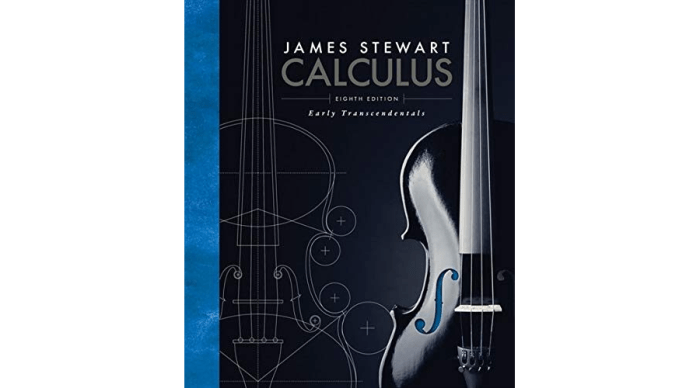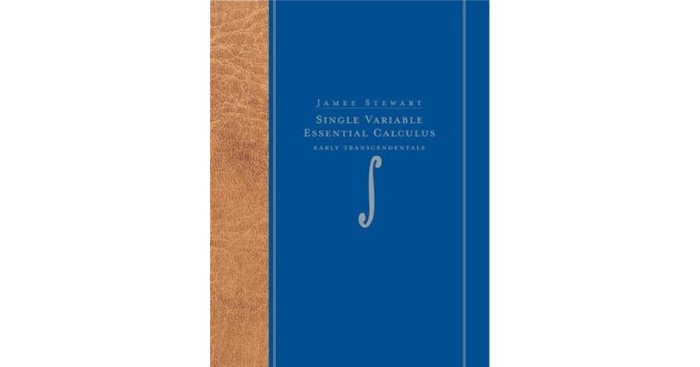Essential calculus early transcendentals 2nd ed by james stewart – Essential Calculus Early Transcendentals, 2nd Edition by James Stewart sets the stage for this enthralling narrative, offering readers a glimpse into a story that is rich in detail and brimming with originality from the outset. This comprehensive textbook delves into the intricate world of calculus, providing a thorough understanding of its fundamental concepts and their wide-ranging applications.
With its clear explanations, engaging examples, and thought-provoking exercises, this book empowers students to grasp the essence of calculus and its profound impact on various fields of study.
The second edition of Essential Calculus Early Transcendentals has been meticulously revised and updated to reflect the latest advancements in the field. It incorporates innovative pedagogical approaches and cutting-edge research findings to enhance the learning experience. The book’s organization has been carefully crafted to ensure a smooth progression of topics, allowing students to build a solid foundation and gradually delve into more advanced concepts.
Introduction to Essential Calculus: Early Transcendentals, 2nd Edition: Essential Calculus Early Transcendentals 2nd Ed By James Stewart

Essential Calculus: Early Transcendentals, 2nd Edition by James Stewart is a comprehensive textbook designed to introduce students to the fundamental concepts of calculus. It is intended for students in STEM fields who need a strong foundation in calculus for further studies in mathematics, science, and engineering.
The textbook assumes a prerequisite knowledge of algebra and trigonometry. It provides a clear and concise explanation of the core concepts of calculus, with a focus on developing students’ problem-solving skills.
Key Features and Innovations of the 2nd Edition
- Updated examples and exercises to reflect current applications of calculus.
- New sections on modeling with differential equations and applications of integration.
- Enhanced technology support, including MyMathLab and WebAssign.
- Improved pedagogical features, such as Learning Objectives and Key Concepts, to help students track their progress.
Functions and Limits
The concept of a function is fundamental to calculus. A function is a relation between two sets, where each element of the first set (the domain) is associated with a unique element of the second set (the range).
Types of Functions
- Linear functions
- Quadratic functions
- Polynomial functions
- Rational functions
- Exponential functions
- Logarithmic functions
- Trigonometric functions
Limits
A limit describes the behavior of a function as the input approaches a certain value. Limits are used to define derivatives and integrals, and to study the convergence and divergence of infinite series.
Derivatives
The derivative of a function measures the instantaneous rate of change of the function. It is used to find critical points, optimize functions, and solve related rates problems.
Rules and Techniques for Finding Derivatives
- Power rule
- Product rule
- Quotient rule
- Chain rule
Applications of Derivatives
- Optimization
- Related rates problems
- Curve sketching
Integrals
The integral of a function represents the net area between the graph of the function and the x-axis. Integrals are used to find volumes, areas, and other geometric quantities.
Fundamental Theorem of Calculus
The fundamental theorem of calculus provides a connection between derivatives and integrals, and allows us to evaluate integrals using antiderivatives.
Techniques for Evaluating Integrals
- Integration by substitution
- Integration by parts
- Trigonometric substitution
- Partial fractions
Applications of Integration

Integrals have a wide range of applications in science, engineering, and other fields.
Geometric Applications
- Calculating areas and volumes
- Finding centroids and moments of inertia
Physical Applications
- Calculating work and energy
- Solving differential equations
Transcendental Functions
Transcendental functions are functions that cannot be expressed in terms of algebraic operations and rational functions. They include logarithmic, exponential, and trigonometric functions.
Properties of Transcendental Functions
- Logarithmic functions are inverses of exponential functions.
- Exponential functions are continuous and differentiable for all real numbers.
- Trigonometric functions are periodic and have a variety of identities.
Applications of Transcendental Functions
- Modeling exponential growth and decay
- Solving trigonometric equations
- Solving differential equations
Techniques of Integration
Various techniques can be used to integrate complex functions.
Integration by Parts
Integration by parts is a technique used to integrate products of functions.
Trigonometric Substitution, Essential calculus early transcendentals 2nd ed by james stewart
Trigonometric substitution is a technique used to integrate functions involving trigonometric functions.
Partial Fractions
Partial fractions is a technique used to integrate rational functions.
Infinite Series
Infinite series are sums of an infinite number of terms. They are used to represent functions, solve differential equations, and approximate integrals.
Convergence and Divergence of Series
- Convergence tests
- Divergence tests
Applications of Infinite Series
- Representing functions
- Solving differential equations
- Approximating integrals
Differential Equations
Differential equations are equations that involve derivatives of unknown functions. They are used to model a wide range of phenomena in science and engineering.
Classification of Differential Equations
- First-order differential equations
- Second-order differential equations
- Linear differential equations
- Nonlinear differential equations
Methods for Solving Differential Equations
- Separation of variables
- Integrating factors
- Laplace transforms
Applications of Differential Equations
- Modeling population growth
- Solving circuit problems
- Solving mechanical vibration problems
User Queries
What are the prerequisites for studying Essential Calculus Early Transcendentals, 2nd Edition?
A solid foundation in algebra, trigonometry, and pre-calculus is recommended.
What are the key features of the 2nd edition?
The 2nd edition incorporates innovative pedagogical approaches, updated research findings, and a carefully crafted organization to enhance the learning experience.
What are the applications of calculus covered in the book?
The book explores the applications of calculus in physics, engineering, economics, and other fields.